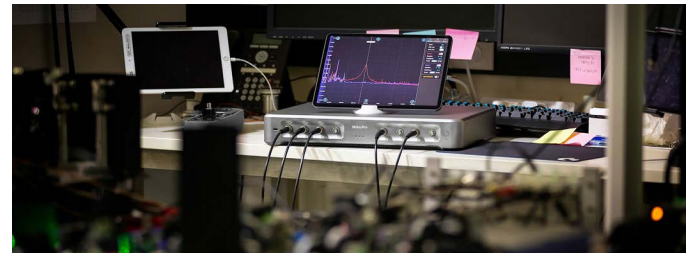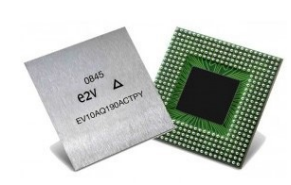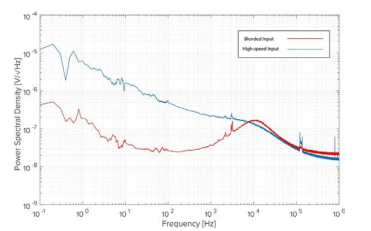Leveraging the crosspoint switching characteristics and best-in-class low-frequency noise performance of the ADC EV10AQ190 to implement software-defined instrumentation Moku:Pro
Moku:Pro is a scalable, high-performance test solution for developing and verifying next-generation devices and systems. It implements a software-defined instrument with 4 input channels and 4 output channels, with high flexibility.
The high-speed, high-precision data converter EV10AQ190 from Teledyne e2v is the best choice for this platform, providing Moku:Pro with first-class data acquisition performance. Its unique crosspoint switch enables the system to dynamically switch the channel usage mode and provide high-speed interleaved data; its excellent low-frequency noise characteristics help Moku:Pro achieve industry-leading noise performance using advanced ADC technology.
MOKU:PRO: A Software-Defined Instrumentation Platform for the Most Demanding Research and Engineering Applications

Moku:Pro achieves outstanding performance and flexibility through a sophisticated FPGA-based architecture, a high-bandwidth, low-noise analog front end, and powerful networking and storage. You get all the instruments you need quickly without sacrificing performance for flexibility. The innovative hybrid front-end design enables frequency-dependent signal mixing of multiple ADCs, providing excellent noise performance from audio to RF. It uses a single hardware platform to implement more than 10 different instruments, allowing engineers and researchers to simplify their test benches and even bring the lab home.
Moku:Pro enables engineering teams to work from home by integrating essential test equipment such as oscilloscopes and waveform generators into a single hardware platform. With its small size, power consumption as low as 115W and a suite of core test instruments included, remote work has never been easier. Moku:Pro's multi-instrument mode allows you to run multiple instruments simultaneously and connect them to each other to build a customized test system. Advanced users can access Moku:Pro's FPGA to implement custom digital signal processing by writing their own VHDL code. This cloud-based tool can be accessed directly from your browser, allowing you to develop, compile and implement custom algorithms in Moku:Pro without downloading software.
EV10AQ190: High-speed ADC for cutting-edge data acquisition on the MOKU:PRO platform

The EV10AQ190 is a 10-bit high-speed ADC from Teledyne e2v with 3.2GHz input analog bandwidth for high-speed, high-performance data acquisition. It contains internal crosspoint switches and a multi-core architecture that can be dynamically configured as a four-channel device up to 1.25Gsps, a dual-channel device up to 2.5Gsps, or a single-channel device up to 5Gsps. Moku:Pro takes advantage of this feature to enable its multi-instrument capability to switch between different ADC channel configurations.

Industry-leading noise performance is achieved by combining this 10-bit high-speed ADC with a lower-speed ADC using Liquid Instruments’ Hybrid ADC technology. This hybrid ADC technology is made possible in part by the EV10AQ190’s top-notch low-frequency noise performance (1/f noise). Here the 1/f performance of the high-speed EV10AQ190 and the performance improvement using Liquid Instruments’ Hybrid ADC technology are shown.
Building on the success of the EV10AQ190, Teledyne e2v recently released the successor 12-bit product EV12AQ605, which further breaks through the limitations of data acquisition in terms of resolution, sampling speed and performance.
The design of the crosspoint switch is continued to ensure the flexibility of channel usage for large data acquisition applications. In addition, it also improves the ease of use of the ADC through features such as serial interface and simpler synchronization mechanism.
Previous article:imc launches NVH acoustic and vibration measurement system
Next article:Naxin Micro launches new isolated Sigma-Delta modulator isolated sampling chip
Recommended ReadingLatest update time:2024-11-16 10:14





- Popular Resources
- Popular amplifiers
- High signal-to-noise ratio MEMS microphone drives artificial intelligence interaction
- Advantages of using a differential-to-single-ended RF amplifier in a transmit signal chain design
- ON Semiconductor CEO Appears at Munich Electronica Show and Launches Treo Platform
- ON Semiconductor Launches Industry-Leading Analog and Mixed-Signal Platform
- Analog Devices ADAQ7767-1 μModule DAQ Solution for Rapid Development of Precision Data Acquisition Systems Now Available at Mouser
- Domestic high-precision, high-speed ADC chips are on the rise
- Microcontrollers that combine Hi-Fi, intelligence and USB multi-channel features – ushering in a new era of digital audio
- Using capacitive PGA, Naxin Micro launches high-precision multi-channel 24/16-bit Δ-Σ ADC
- Fully Differential Amplifier Provides High Voltage, Low Noise Signals for Precision Data Acquisition Signal Chain
- Innolux's intelligent steer-by-wire solution makes cars smarter and safer
- 8051 MCU - Parity Check
- How to efficiently balance the sensitivity of tactile sensing interfaces
- What should I do if the servo motor shakes? What causes the servo motor to shake quickly?
- 【Brushless Motor】Analysis of three-phase BLDC motor and sharing of two popular development boards
- Midea Industrial Technology's subsidiaries Clou Electronics and Hekang New Energy jointly appeared at the Munich Battery Energy Storage Exhibition and Solar Energy Exhibition
- Guoxin Sichen | Application of ferroelectric memory PB85RS2MC in power battery management, with a capacity of 2M
- Analysis of common faults of frequency converter
- In a head-on competition with Qualcomm, what kind of cockpit products has Intel come up with?
- Dalian Rongke's all-vanadium liquid flow battery energy storage equipment industrialization project has entered the sprint stage before production
- Allegro MicroSystems Introduces Advanced Magnetic and Inductive Position Sensing Solutions at Electronica 2024
- Car key in the left hand, liveness detection radar in the right hand, UWB is imperative for cars!
- After a decade of rapid development, domestic CIS has entered the market
- Aegis Dagger Battery + Thor EM-i Super Hybrid, Geely New Energy has thrown out two "king bombs"
- A brief discussion on functional safety - fault, error, and failure
- In the smart car 2.0 cycle, these core industry chains are facing major opportunities!
- The United States and Japan are developing new batteries. CATL faces challenges? How should China's new energy battery industry respond?
- Murata launches high-precision 6-axis inertial sensor for automobiles
- Ford patents pre-charge alarm to help save costs and respond to emergencies
- New real-time microcontroller system from Texas Instruments enables smarter processing in automotive and industrial applications
- If you have original works, I will give you rewards, up to 500 yuan in cash rewards
- Submit your idea, experience MPS products or evaluation boards for free, and win a backpack, Bluetooth wireless headset, and 10,000 yuan in cash!
- Microchip Spring Sale, popular development tools up to 60% off!
- The 3 big benefits of the start of the Year of the Tiger are brought to you by Murata Tmall flagship store
- Power supply obstacles + small mistakes in charging management
- [NXP Rapid IoT Review] + The mobile APP can finally connect to the kit
- A novice asks for advice, how can a switching power supply achieve a regulated output without using a 431?
- MSP430F5438+DTH11 Example Code
- [Project source code] Altera Altium format device library and package including Cyclone V
- 【Qinheng RISC-V core CH582】Upgrade program via Bluetooth

 ESP32-S3 source code
ESP32-S3 source code 【Follow me Season 2 Episode 2】Arduion UR4 homework submission code
【Follow me Season 2 Episode 2】Arduion UR4 homework submission code MCU C language programming and Proteus simulation technology (Xu Aijun)
MCU C language programming and Proteus simulation technology (Xu Aijun)
















 京公网安备 11010802033920号
京公网安备 11010802033920号